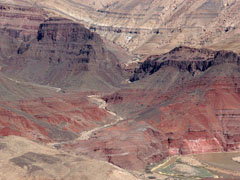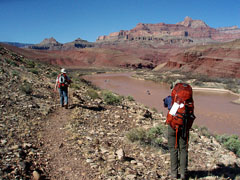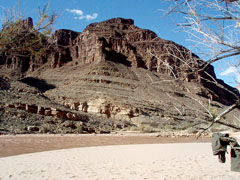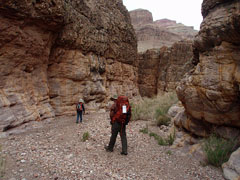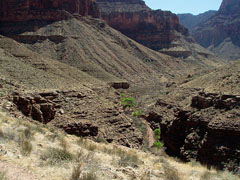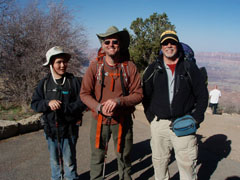He planned to hike down the Tanner Trail, along the Escalante Route, up the Tonto Trail until we could climb to Horseshoe Mesa and exit via the Grandview Trail. As I had not done this complete route before, I enthusiastically accepted.
Matthew is becoming quite the backpacking pro, having been on more than a few trips with his dad. Although Bill planned a conservative hiking itinerary, that didn't mean we would take it easy. We were up around 5:30 every morning and usually hiking into the middle of the afternoon each day. That gave us time to set up camp, relax and cook dinner during daylight hours. I like it.
We started with a two-day hike down the Tanner Trail to the river.
The first night was a dry camp atop the Redwall when our packs were at their heaviest. Matthew pulled his weight, lugging a pack that was proportionally as heavy as ours. The next day we reached the river in the early afternoon. It was quite warm in the sun, with temperatures into the 70s, and we mostly kept to the shade until sunset.
SLEEPING ON THE BEACH
Day three would start us on the "Escalante Route." We only planned to go as far as Cardenas Creek, about three miles away. We reached the well-developed river camp at Cardenas before noon, which we had all to ourselves. Well, to ourselves and to the largest mouse I've ever seen. I swear it was as big as a cat.
The next day we hiked up a thousand feet in order to wrap our way around and into Escalante Canyon. This would be one of our toughest hiking days and the weather cooperated beautifully with lots of overcast until the early afternoon. Matthew is still building up his hiking skills and relied on his father's coaching when we crossed over a jumbled boulder field. But, once the trail flattened out I was the one calling out for rest breaks.
At our camp we decided to leave the tents packed up and just sleep out on the beach. Like all the other nights on our trip, it was pleasant, with the overnight low probably in the mid to upper 40s.
TWO HEART-STOPPERS
On the fifth day, we hiked over to and then down the impressive slot in 75 Mile Canyon. Once at the river, we spied a river trip and enjoyed watching the boats run the rapids. From here we could see downriver to the first of two heart-stoppers that make this a "route" and not a trail -- the "Papago Wall." The wall most certainly will require a rope for lowering packs, and many will want to do the same to raise them up.
Just past the wall, and out of our view, was the other heart-stopper -- the Papago Slide. The slide not only gives you a case of vertigo but adds a dose of terror as you make your way through precariously perched rocks that look like they could start sliding anew any time.
You may find yourself on your knees in places, perhaps just to say a short prayer. It is only about six-tenths of a mile from the mouth of Papago to Hance Rapids, but it took us two hours to do it.
Our sixth day took us to Hance Creek, where we would spend our final night.
We had the camping area among the cottonwoods all to ourselves. The next morning we awoke to yet another beautiful day and began the 3,600-foot climb to reach the rim. We learned from hikers coming down that the snow and ice at the top of the trail was mostly gone and presented no concerns. That was a relief for us to hear.
We three very happy hikers reached the rim at 4 p.m. We talked about food a lot the last day and looked forward to a meal in Cameron. Matthew had a well-deserved cheeseburger and another Grand Canyon adventure under his belt.
Dennis Foster is an avid Grand Canyon backpacker and has recorded more than 300 separate hikes since 1977.
BACKCOUNTRY PERMITS
Getting a backcountry permit at the Grand Canyon is a rather involved process.
You must first review the various use areas in order to determine where you'd like to camp during your trip. You can apply for a permit up to four months in advance of the month your trip begins. For hikes in March, an application will be accepted no earlier than November 1st of the previous year. You must apply in writing by fax, snail mail or in-person. No e-mailed applications are accepted. You can only make an in-person request three months in advance of the month your trip begins.
The most popular backpacking months are March, April, May and October, each getting more than 10,000 user nights. According to data from 2008, 25 percent to 50 percent of permit requests made for these months were denied, due to space limitations imposed by the Park Service. Conversely, January is the lightest month for backpacking with only about 2,000 user nights being permitted.
Visit www.nps.gov/grca for more information for planning a trip and the forms needed to make a permit request.










